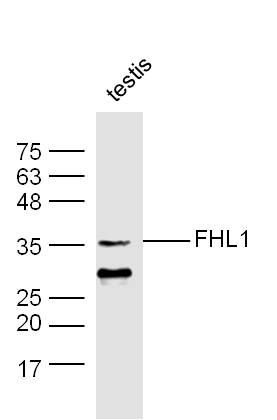FHL1 Polyclonal Antibody
Purified Rabbit Polyclonal Antibody (Pab)
- 产品详情
- 实验流程
Application
| WB, IHC-P, IHC-F, IF, ICC, E |
|---|---|
| Primary Accession | Q13642 |
| Reactivity | Rat, Pig, Dog, Bovine |
| Host | Rabbit |
| Clonality | Polyclonal |
| Calculated MW | 36263 Da |
| Physical State | Liquid |
| Immunogen | KLH conjugated synthetic peptide derived from human FHL1 |
| Epitope Specificity | 151-250/323 |
| Isotype | IgG |
| Purity | affinity purified by Protein A |
| Buffer | 0.01M TBS (pH7.4) with 1% BSA, 0.02% Proclin300 and 50% Glycerol. |
| SUBCELLULAR LOCATION | Isoform 1: Cytoplasm. Isoform 3: Cytoplasm. Nucleus. Isoform 2: Nucleus. Cytoplasm, cytosol. Note=Predominantly nuclear in myoblasts but is cytosolic in differentiated myotubes. |
| SIMILARITY | Contains 3 LIM zinc-binding domains. |
| DISEASE | Defects in FHL1 are the cause of X-linked dominant scapuloperoneal myopathy (SPM) [MIM:300695]. Scapuloperoneal syndrome (SPS) was initially described more than 120 years ago by Jules Broussard as 'une forme hereditaire d'atrophie musculaire progressive' beginning in the lower legs and affecting the shoulder region earlier and more severely than distal arm. The etiology of this condition remains unclear. Defects in FHL1 are the cause of X-linked myopathy with postural muscle atrophy (XMPMA) [MIM:300696]. Myopathies are inherited muscle disorders characterized by weakness and atrophy of voluntary skeletal muscle, and several types of myopathy also show involvement of cardiac muscle. XMPMA is a distinct form of adult-onset X-linked recessive myopathy with several features in common with other myopathies, but the presentation of a pseudoathletic phenotype, scapuloperoneal weakness, and bent spine is unique and might render the clinical phenotype distinguishable from other myopathies. Defects in FHL1 are the cause of X-linked severe early-onset reducing body myopathy (RBM) [MIM:300717]. RBM is a rare muscle disorder causing progressive muscular weakness and characteristic intracytoplasmic inclusions in myofibers. Clinical presentations of RBM have ranged from early onset fatal to childhood onset to adult onset cases. Defects in FHL1 are the cause of X-linked childhood-onset reducing body myopathy (CO-RBM) [MIM:300718]. This disorder is allelic to severe early-onset reducing body myopathy (RBM) [MIM:300717]. |
| Important Note | This product as supplied is intended for research use only, not for use in human, therapeutic or diagnostic applications. |
| Background Descriptions | This gene encodes a member of the four-and-a-half-LIM-only protein family. Family members contain two highly conserved, tandemly arranged, zinc finger domains with four highly conserved cysteines binding a zinc atom in each zinc finger. Expression of these family members occurs in a cell- and tissue-specific mode and these proteins are involved in many cellular processes. Mutations in this gene have been found in patients with Emery-Dreifuss muscular dystrophy. Multiple alternately spliced transcript variants which encode different protein isoforms have been described.[provided by RefSeq, Nov 2009] |
| Gene ID | 2273 |
|---|---|
| Other Names | Four and a half LIM domains protein 1, FHL-1, Skeletal muscle LIM-protein 1, SLIM, SLIM-1, FHL1, SLIM1 |
| Target/Specificity | Isoform 1 is highly expressed in skeletal muscle and to a lesser extent in heart, placenta, ovary, prostate, testis, small intestine, colon and spleen. Expression is barely detectable in brain, lung, liver, kidney, pancreas, thymus and peripheral blood leukocytes. Isoform 2 is expressed in brain, skeletal muscle and to a lesser extent in heart, colon, prostate and small intestine. Isoform 3 is expressed in testis, heart and skeletal muscle. |
| Dilution | WB=1:500-2000,IHC-P=1:100-500,IHC-F=1:100-500,ICC=1:100-500,IF=1:100-500,ELISA=1:5000-10000 |
| Format | 0.01M TBS(pH7.4) with 1% BSA, 0.09% (W/V) sodium azide and 50% Glyce |
| Storage | Store at -20 °C for one year. Avoid repeated freeze/thaw cycles. When reconstituted in sterile pH 7.4 0.01M PBS or diluent of antibody the antibody is stable for at least two weeks at 2-4 °C. |
| Name | FHL1 |
|---|---|
| Synonyms | SLIM1 |
| Function | May have an involvement in muscle development or hypertrophy. |
| Cellular Location | [Isoform 1]: Cytoplasm. [Isoform 2]: Nucleus. Cytoplasm, cytosol. Note=Predominantly nuclear in myoblasts but is cytosolic in differentiated myotubes |
| Tissue Location | Isoform 1 is highly expressed in skeletal muscle and to a lesser extent in heart, placenta, ovary, prostate, testis, small intestine, colon and spleen. Expression is barely detectable in brain, lung, liver, kidney, pancreas, thymus and peripheral blood leukocytes. Isoform 2 is expressed in brain, skeletal muscle and to a lesser extent in heart, colon, prostate and small intestine. Isoform 3 is expressed in testis, heart and skeletal muscle |
Research Areas
For Research Use Only. Not For Use In Diagnostic Procedures.
Application Protocols
Provided below are standard protocols that you may find useful for product applications.
终于等到您。ABCEPTA(百远生物)抗体产品。
点击下方“我要评价 ”按钮提交您的反馈信息,您的反馈和评价是我们最宝贵的财富之一,
我们将在1-3个工作日内处理您的反馈信息。
如有疑问,联系:0512-88856768 tech-china@abcepta.com.
¥ 1,500.00
Cat# AP58248























 癌症的基本特征包括细胞增殖、血管生成、迁移、凋亡逃避机制和细胞永生等。找到癌症发生过程中这些通路的关键标记物和对应的抗体用于检测至关重要。
癌症的基本特征包括细胞增殖、血管生成、迁移、凋亡逃避机制和细胞永生等。找到癌症发生过程中这些通路的关键标记物和对应的抗体用于检测至关重要。 为您推荐一个泛素化位点预测神器——泛素化分析工具,可以为您的蛋白的泛素化位点作出预测和评分。
为您推荐一个泛素化位点预测神器——泛素化分析工具,可以为您的蛋白的泛素化位点作出预测和评分。 细胞自噬受体图形绘图工具为你的蛋白的细胞受体结合位点作出预测和评分,识别结合到自噬通路中的蛋白是非常重要的,便于让我们理解自噬在正常生理、病理过程中的作用,如发育、细胞分化、神经退化性疾病、压力条件下、感染和癌症。
细胞自噬受体图形绘图工具为你的蛋白的细胞受体结合位点作出预测和评分,识别结合到自噬通路中的蛋白是非常重要的,便于让我们理解自噬在正常生理、病理过程中的作用,如发育、细胞分化、神经退化性疾病、压力条件下、感染和癌症。






